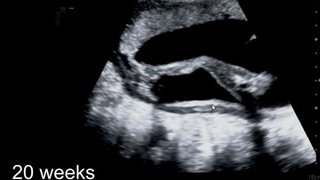Lingering abdominal bulge after baby? It could be diastasis recti
August 8, 2017

Pregnancy can do strange things to women’s bodies. Our bellies stretch in weird ways, sometimes leaving lasting marks. While some moms get stretch marks or “tiger stripes” on the skin surface only, others develop diastatis recti (DRA), a separation of the abdominal muscles that shows up as a bulge or dome at the center of the abdomen when using your abdominal muscles forcefully.
Robyn Horsager, M.D., and I see many women during pregnancy and after they have a baby who don’t know they have diastasis recti – they assume the lingering abdominal bulge is just part of having a baby. Or if they have been diagnosed, they don’t know how to fix it.
We give women who might have DRA three pieces of advice:
- Don’t ignore or accept it. It’s common, but not “normal,” and it requires help from a health care professional to properly rehabilitate.
- Hold up on the crunches! While it is important to stay strong and health during pregnancy, performed incorrectly, this exercise won’t help and will often make the condition worse.
- Think beyond the surface. I completely understand wanting to tighten up your abdominals postpartum, but DRA can contribute to long-term body pain and women’s health problems that we can help you avoid.
Before we start physical therapy for diastasis recti, we make sure our patients understand what it is, what can happen if it’s not taken care of, and how you can regain strength in your abdominal muscles to prevent further damage.
What is diastasis recti, and what causes it?
DRA is an abnormal separation of the muscles in the front of your tummy (your rectus abdominus muscles). The condition is typically painless, and it happens when hormone changes cause the ligaments separating the abdominal muscles to thin and stretch out as your belly expands to accommodate a growing baby. During pregnancy, it can be caused by:
DRA is common, but we don’t consider it “normal” – it’s a muscle injury that requires medical care. DRA happens most often during a woman’s first pregnancy, and women who carry twins or multiples are more likely to develop it. The condition often is detected during the third trimester of pregnancy, and the rest are after pregnancy when the trademark abdominal separation and bulge is easier to see.
- Overlengthening, or excessive stretching, of the rectus abdominus muscles, which makes them weak, requiring more effort and exertion to use them.
- Poor coordination of the deep, front, and side abdominal muscles (they can pull against each other instead of working together)
- Increased weight gain
- Poor posture or body mechanics as your belly grows heavier
- Improper abdominal use and lack of strengthening
When we suspect a woman has DRA, we can diagnose it with a physical exam or ultrasound. For the physical exam, we press gently on the abdomen to feel for muscle separation between the muscle bellies while the women is curling her head and shoulders off the table. Then we feel for a softening of the ligaments and separation of the muscles which can show up anywhere from the pubic bone to the rib cage.
You can check your own body for DRA as well using the same technique. In general, if your abdominal separation is more than 2 finger-widths in the vertical line from your pubic bone to your rib cage (which is best felt when using your abdominal muscles actively), you might have DRA. Also, if you are unable to contract or squeeze the muscles in the front of your tummy, and are struggling with strengthening them, you might have DRA. A physical therapist can help properly diagnose and show you how to monitor this condition on your own.
What can happen if I don’t get treatment for DRA?
If you have a lingering abdominal bulge related to a DRA on your abdomen, and it doesn’t bother you, more power to you! However, that doesn’t mean you shouldn’t get it checked out.
Beyond its cosmetic appearance, diastasis recti can contribute to painful women’s health and sexual complications later in life, including:
- Core weakness: Our ab muscles are an important part of the body’s core, which helps to support our entire lumbopelvic region and promotes mobility. Our bodies are only as strong as our weakest link. If our abdominal muscles are weak, our internal organs don’t get the support they need, and neither do our backs. This can result in low back pain and many of the conditions listed below.
- Women’s health and sexual problems: Urinary incontinence (inability to hold in pee) and other pelvic floor disorders such as pelvic organ prolapse and painful intercourse are three women’s health conditions that cause pain and discomfort, and they can affect quality of life and relationships.
- Cosmetic appearance: Not looking like your pre-baby self can affect your self-esteem, quality of life, sex life, and more.
Dr. Julie Wiebe, a physical therapist colleague in Los Angeles, says diastasis recti is like a zipper that doesn’t close properly. When you try to zip up a pair of jeans and the zipper is broken and bulging open, you don’t just go about your day as if nothing is wrong. You have to assess and address the whole situation, from the cogs of the zipper to the surrounding material, as well as the way you move to prevent it from splitting further.
That’s the same approach we take when treating DRA. It’s not a spot fix for one part that’s broken – we need to approach it as a series of parts, head to toe, that work together.
Physical therapy exercises to repair and prevent DRA
We teach women many exercise and moves to repair DRA and prevent it from getting worse. Please note, Texas regulations require a referral from your Ob/Gyn or other doctor who is caring for you in order to participate in physical therapy.
Related reading: Body after birth: Treating post-pregnancy problems
The first thing our physical therapists teach women with DRA is how to practice good posture. It helps the muscles align properly and makes it easier to breathe, particularly during exercises such as weightlifting when you may be inclined to hold your breath.
One important muscle you use for central stability is the transversus abdominus muscle, which is your “inner girdle” that assists with breathing and holds up your core. We focus on this muscle in physical therapy to help you learn to strengthen it, tighten up the muscle gap left by DRA, and promote better breathing. Two exercises that strengthen this muscle are planks and “bird-dog” exercises.
We often recommend women with DRA stop doing crunches. Women often are shocked when we say that, but crunches are easily performed incorrectly when there is a weak link in the system.
Outside of physical therapy, work on your body mechanics, such as breath control and posture while maintaining a neutral core. This is important for lifting, such as lifting your baby, and standing. Your spine should have a gentle curve when you stand, your breathing should be relaxed as you move, and you should avoid holding your breath when lifting your baby.
As with many conditions, achieving and maintaining a healthy weight before, during, and after pregnancy can help reduce the size of your abdomen over which the muscles must stretch and help tighten your muscles again after baby arrives.
If physical therapy proves unsuccessful for your diastasis recti, your doctor may recommend surgery to tighten up the loose, bulging stomach muscles. Talk to your doctor about all of your options before you decide which route to take.
To talk with a physical therapist about care before, during, or after pregnancy, request an appointment online or call 214-645-8300.










